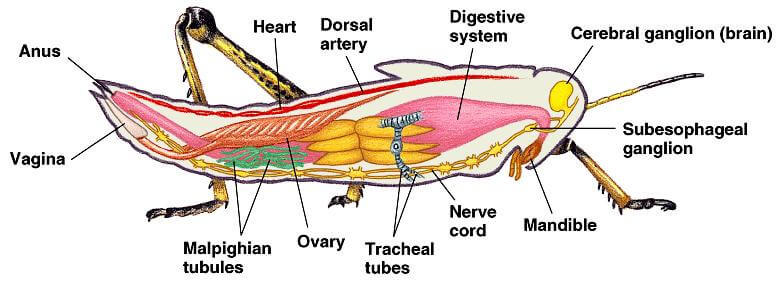Respiratory, digestive, circulation, reproduction and nervous systems of insects. Information about the internal Anatomy and Physiology Of Insects
Although the mouthparts and other external features of insects may vary greatly, all adult insects have the same internal body systems and tissues. Much of the space inside the insect’s body is occupied by the muscles, but the body also contains a digestive system, a nervous system, a circulatory system, respiratory system, and a reproductive system. inside the insect’s body are also masses of fat cells that are connected to form a structure called the fat body. In addition, there are structures for excretion, sense organs, and in some insects there are structures for producing sound or light.

Muscles.
Insects have a complex muscular system that may consist of as many as several thousand individual muscles. The muscles generally extend from one sclerite to another, but they may also be attached to special projections that extend inward from the cuticle. The muscular frame-work in the head, called the tentorium, controls the movements of the antennae, the mouthparts, and other structures. The thorax is largely occupied by the indirect muscles, which move the wings up and down. The twisting movements of the wings, which give control and direction to flight, are controlled by the direct muscles, which are attached to each wing base. Other muscles of the thorax control the movements of the legs.
In the abdomen, muscular action produces the powerful movements necessary for breathing and egg laying. In addition, there are bands of muscle surrounding the digestive tract and the heart.
Fat Body.
In addition to being filled with blood, the abdominal cavity is largely occupied by a mass of fatty cells that are loosely connected by membranous strands. These cells and strands make up the fat body, which is the body’s principal organ for storing food materials. The fat body is an active organ made up of cells that are similar to the cells of the mesenteron. The scattered arrangement of the fat cells increases the surface area between the fat body and the blood, which receives the food molecules as they are absorbed through the mesenteron wall. The food molecules that are not used by the body cells are stored in the fat body.
The size of the fat body varies considerably, depending on the insect’s stage of development and certain physiological conditions. For example, an insect about to undergo hibernation has a very large fat body and thus a swollen abdomen. When the insect comes out of hibernation, it appears to be greatly emaciated, having consumed most of its stored food.